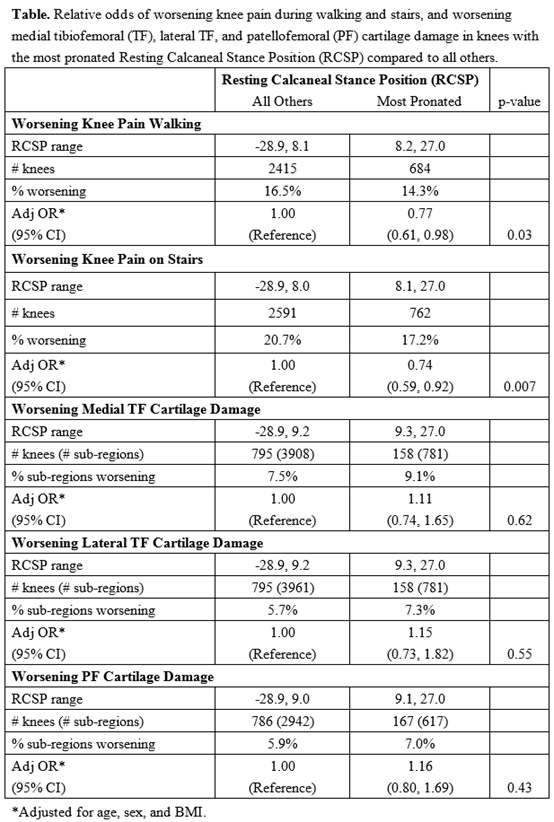Session Information
Date: Tuesday, November 10, 2015
Title: Osteoarthritis - Clinical Aspects Poster II: Biomarkers, Biomechanics and Health Services Research
Session Type: ACR Poster Session C
Session Time: 9:00AM-11:00AM
Background/Purpose:
Pronated foot posture is prevalent in older adults with knee cartilage
damage and younger adults with knee pain. Yet, there is disagreement about the
role of the pronated foot in knee OA. Many footwear interventions for older
adults encourage a highly pronated foot posture in an effort to redistribute
provocative loads away from the medial tibiofemoral (TF) compartment. Conversely,
interventions for younger adults often seek to correct the pronated foot in order
to minimize painful loading of adjacent knee compartments. In adults that have
or at risk of knee OA, we assessed the relation of pronated foot posture to
2-year risk of worsening knee pain during walking and stairs, and worsening medial
TF, lateral TF, and patellofemoral (PF) cartilage damage.
Methods: The
Multicenter Osteoarthritis Study (MOST) includes adults aged 50-79 years that
have or are at risk of knee OA. At the 60 month exam, foot posture was measured
by a single reader (ICC= 0.69) as Resting Calcaneal Stance Position (RCSP) from
photos acquired in bipedal standing. RCSP is a validated measure, with higher values
indicating a more pronated foot. From 1.0 T MRIs at 60 and 84 months, readers scored
1 knee per subject for cartilage damage in each sub-region of the medial TF,
lateral TF, and PF compartments using WORMS (weighted kappa > 0.63). Worsening
damage was any increase in WORMS score. Worsening knee pain during walking and
stairs was defined over the same period as any increase in Likert score on corresponding
questions of the WOMAC index. After forming case-based quintiles of increasing
RCSP, we combined quintiles 1-4 and used logistic regression to estimate the odds
of worsening knee pain or compartment-specific cartilage damage in knees with
the most pronated feet (quintile 5) as compared to all others (quintiles 1-4).
Adjustments were made for age, sex, and BMI. GEE accounted for non-independent knees
in a person, or sub-regions in a compartment.
Results: 2021
(mean age 67.6 ± 7.7 years, BMI 30.8 ± 6.1 kg/m2, 61.0% female)
and 2412 participants contributed 2 knees each to the analysis of worsening
knee pain during walking and stairs, respectively, and 1 knee each to the
analysis of worsening medial TF (1185 knees), lateral TF (1145 knees), and PF (1145
knees) cartilage damage. Mean RCSP was 5.1 ± 4.7°. Odds of worsening knee pain
during walking and stairs were 23% lower (OR= 0.77, p= 0.03) and 26% lower (OR=
0.74, p< 0.01), respectively, among knees with the most highly pronated foot
posture (RSCP 8.2° to 27.0°). There was no association between pronated foot
posture and risk of worsening knee cartilage damage (see table).
Conclusion: In adults that have or are at-risk of knee OA, a
highly pronated foot posture is protective against worsening
knee pain during walking and stair climbing, but does not protect against
worsening knee cartilage damage.
To cite this abstract in AMA style:
Gross KD, Hillstrom HJ, Quinn EK, Nevitt MC, Lewis CE, Torner J, Felson DT. Relation of Pronated Foot Posture to Risk of Worsening Knee Pain during Gait and Compartment-Specific Knee Cartilage Damage [abstract]. Arthritis Rheumatol. 2015; 67 (suppl 10). https://acrabstracts.org/abstract/relation-of-pronated-foot-posture-to-risk-of-worsening-knee-pain-during-gait-and-compartment-specific-knee-cartilage-damage/. Accessed .« Back to 2015 ACR/ARHP Annual Meeting
ACR Meeting Abstracts - https://acrabstracts.org/abstract/relation-of-pronated-foot-posture-to-risk-of-worsening-knee-pain-during-gait-and-compartment-specific-knee-cartilage-damage/

